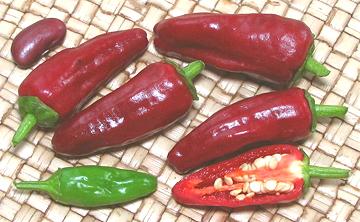
[C. annuum]
The various ethnicities of Anatolia, Caucasus and the Levant may not get along real well, but their ingredients and cuisines overlap substantially into a coherent region. Egypt, on the other hand, is in North Africa, but has strongly influenced the Levant.
As far as we can tell, the Turks got chilis from Portuguese traders in the 1500s, and they spread from there to the Levant, Caucasus and Balkan regions, and as far as Hungary.
Countries included in this section are Armenia, Azerbaijan, Georgia, Palestine, Syria, Turkey, Israel, and possibly some Egypt.
More on Chili Peppers.
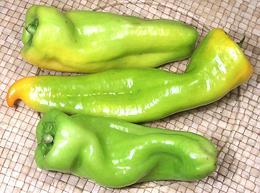 [Capsicum annuum]
[Capsicum annuum]
Fresh yellow-green, up to 8 inches by 2 inches but more commonly
stubbier at 5 to 6 inches by 2 inches diameter, tapered with a usually
blunt end. These are noticeably sweet when they start to yellow but can
have detectable hotness ((H0 to
H1). They have thinner skins, thinner walls and a more subtle
flavor than Bell Peppers, so are good for frying and roasting, similar
to Italian Frying Peppers. They are very like the sweet Hungarian Green
pepper, which stands to reason, since the Hungarians got their peppers
from the Turks. They can be considered interchangeable with those chilis.
 [Halaby (Arab); Capsicum annuum]
[Halaby (Arab); Capsicum annuum]
This important pepper has been long grown around the city of Aleppo in
northern Syria, after which it is named. The Arab name, Halaby, is also
named for the city, which was called Halab in ancient times. Most are
now grown in Turkey due to the endless warfare that has destroyed much
of Aleppo and the surrounding region. This chili is not much used fresh,
most being processed into Aleppo Chili Flake. This is a fairly hot chili
at H6, but the flake made from
it is much milder as the seeds and veins are removed.
Photo borrowed from
Refining Fire Chiles until
the seeds I bought from them bear fruit.
 [Haleb Biber (Armenia); Pul Biber (Turk)]
[Haleb Biber (Armenia); Pul Biber (Turk)]
This is the form most Aleppo Pepper is sold in. Here in Southern
California there was once only the Mild version, but now both Mild and
Hot are available (2019), though actually there isn't a lot of
difference. The flake is not nearly as hot as the chilis themselves,
due to seed and vein removal in the process. This flake is made by salt drying
the fresh chilis until they are partially dry. They are then opened and
the seeds and veins are removed. The last steps are to sun dry and then
grind to flake. The flake is just a little salty from this process.
Subst: Ground Ancho Chili with a little salt is considered the most
acceptable substitute.
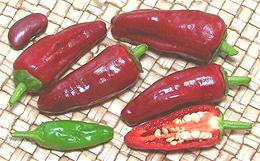 [Capsicum annuum]
[Capsicum annuum]
In Palestine and Egypt, a chili sauce called "Shatta" is made, which
may or may not be made using Shatta Chilis, as the word "Shatta" is
simply a word for "Red" in Arabic. This means there may be other
Chilis in the region also called "Shatta". This plant is small, but is
a good producer. Unlike most chilis this large, they grow point up.
The photo specimens were up to 1.9 inches long and 0.55 inch diameter.
These chilis are just moderately hot
(H4).
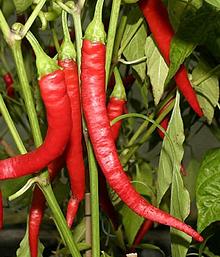 [Capsicum annuum]
[Capsicum annuum]
This chili is very popular in Turkey, and has spread into the Balkans
and Eastern Europe, and no doubt into Armenia. "Sivri Biber" just means
"Hot Pepper" in Turkish. They are long and narrow, growing as long as
9 inches. Their hotness is a bit unpredictable, but can be as low as
H6 and as high as
H8. The plant can grow to 3
feet high, and is very productive. Photo borrowed from
Refining Fire Chiles until
the seeds I bought from them bear fruit.
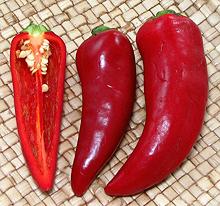 ["Red Jalapeno" (some U.S. supermarkets); Capsicum. annuum]
["Red Jalapeno" (some U.S. supermarkets); Capsicum. annuum]
This chili IS NOT from the Anatolia, Caucasus, Levantine region,
but all the ethnic communities in Southern California seem to have
found it suitable for their cuisines, wherever a medium hot fresh red
chili is needed. While California chili growers produce over a dozen
kinds of fresh green chilis, this, and the tiny Thai chilis, are about it
for red ones. The hotness of Fresno chilis is about
H6, but they are easily
disarmed by removing the seed core and membranes. The attractive flavor
of this chili remains. If a long narrow shape is needed, you'll have to
track down Holland Reds, sometimes sold in the
big chain supermarkets. Fresnos are most reliably found in Asian markets,
particularly Korean and Southeast Asian. For details see our
Fresno Chilis page.